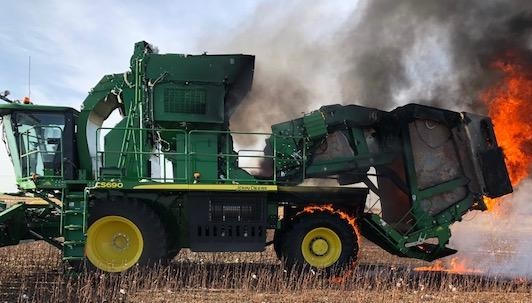How to Protect Your Equipment – and Yourself – This Harvest Season
 Photo: Poctra.com
Photo: Poctra.com
While statistics on fires in cotton harvest machinery are difficult to come by, almost everyone who was paying attention says 2017 in Texas was one of the more troublesome years in memory.
“Two years ago, in 2017, we saw more cotton harvester fires in the PCG service area than we did in 2018,” says Steve Verett, Executive Vice President, Plains Cotton Growers, Inc. Like others in the Southwest, Verett believes the cause of that rash of fires in cotton strippers and cotton pickers was due largely to an abundance of low-micronaire cotton and excessively dry weather. It was a recipe for bad outcomes.
“The next year, in 2018, we saw a more normal distribution of micronaire grades and hardly heard of any fires,” Verett points out.
Still, the conditions that combined to make a perfect storm in 2017 could crop up again in any given planting season. And even under normal conditions, the risk of a fire on board a cotton harvester is present.
“Cotton strippers and pickers have always had fires,” says Steven Monaco, owner of 1st Fire Safety, based in Austin, TX. “That’s been a part of life for everybody. You have all the fibers and all the static electricity, and there’s a lot of dust and parts rubbing together in that machine. It’s always been a situation where a fire could occur.”
The introduction of module-building harvesters has changed the way farm workers are able to respond when faced with a fire outbreak on the machinery they’re operating. John Deere has been proactive in setting emergency and prevention guidelines for their equipment. Beyond those recommendations, Monaco offers a few simple tips to help farmers protect their harvest equipment – and themselves – this coming harvest season:
- Keep up with regular machine maintenance. According to Monaco, servicing the bur extractor and header of the machine is a useful example of preventative maintenance. “Fires can start as a result of poor maintenance,” he says.
- Repair and clean any leaking fuel or oil lines immediately. Flint rocks, branches and electrical wiring can all be the source of sparks on a harvester. Removing accelerants such as fuel and oil spills immediately is a necessity for fire safety.
- Clean the machine off completely two times per day. While farm workers are accustomed to regular cleanings, they can often neglect to check areas that are out of sight – areas like the engine compartment, under the accumulator and under the conveyor belt. Because of their proximity to sensors and flammable hydraulic lines, they should be checked and cleaned vigilantly.
- Inspect the fire extinguishers and fire equipment on the machine. This simple step could prove pivotal in the event of an emergency, according to Monaco.
- Be aware of wind conditions/direction. Fires are much more likely with dry conditions and high winds, so harvester operators should be more cautious in these conditions. Monaco says in the event of a fire, it is best to pull straight into the wind, so that it blows directly at the face of the driver while sitting in the seat.
Nobody wants to lose an expensive piece of equipment to a fire. And even more importantly, no one wants to lose a life in tragedy. That’s why, industry professionals agree, fire prevention and safety should be front of mind as harvest season arrives in 2019.
“When it comes to prevention and safety, you can never have too many reminders,” says Verett.
From Cotton Grower Magazine – August/September 2019









